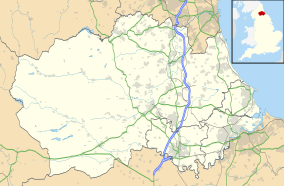Sleightholme Beck Gorge – The Troughs facts for kids
Quick facts for kids Sleightholme Beck Gorge - The Troughs |
|
|---|---|
| Location | Teesdale, North East, England |
| Area | 7.5 ha (19 acres) |
| Established | 1976 |
| Governing body | Natural England |
| Website | Map of site |
Sleightholme Beck Gorge – The Troughs is a special natural area in south-west County Durham, England. It is found in the Teesdale region. This site is a deep valley, also called a gorge. It follows the path of Sleightholme Beck. The gorge stretches from the small village of Sleightholme to where the beck meets the River Greta. This spot is about 3 kilometers upstream from the village of Bowes.
Contents
Discovering Sleightholme Beck Gorge
This amazing place is known as a Site of Special Scientific Interest (SSSI). This means it is very important for its nature and geology. The government protects these sites to keep them safe. Sleightholme Beck Gorge is important for both its living things (biology) and its rocks (geology). Experts have said it is nationally important for its geological features.
What Makes the Rocks Special?
The gorge cuts through a type of rock called Great Limestone. This rock formed a very long time ago during a period called the Namurian. What makes this gorge extra special are the layers of sandstone found in the middle. These sandstone layers show signs of an ancient shoreline. You can see features that look like an old river delta and a barrier bar. These features tell us how the land looked millions of years ago.
Plants You Might See
The gorge has thin soils on its rocky ledges and cracks. It also has slopes covered in loose rocks, called scree. Many interesting plants grow here.
- Ferns: You can find different kinds of ferns. These include maidenhair spleenwort (Asplenium trichomanes), green spleenwort (A. viride), and brittle bladder fern (Cystopteris fragilis). They are very common in this area.
- Shady Spots: In the darker, shadier cracks, you might spot plants that like woodlands. These include wood sorrel (Oxalis acetosella), wood millet (Milium effusum), and dog's mercury (Mercurialis perennis).
- Sunny Spots: In the most open and sunny areas, you can find plants like rue-leaved saxifrage (Saxifraga tridactylites), shining cranesbill (Geranium lucidum), and common whitlow grass (Erophila verna).
- Trees: On the steepest parts of the valley slopes, where it's hard to reach, there are open woodlands. Here, you will find many yew trees (Taxus baccata).
Animals Living Here
This area is also home to some interesting birds.
- Dipper: The dipper has been seen here. These birds are known for "dipping" into the water to find food.
- Common Sandpiper: The common sandpiper has also been recorded at the site. Both the dipper and the common sandpiper likely build their nests and raise their young in this area.


